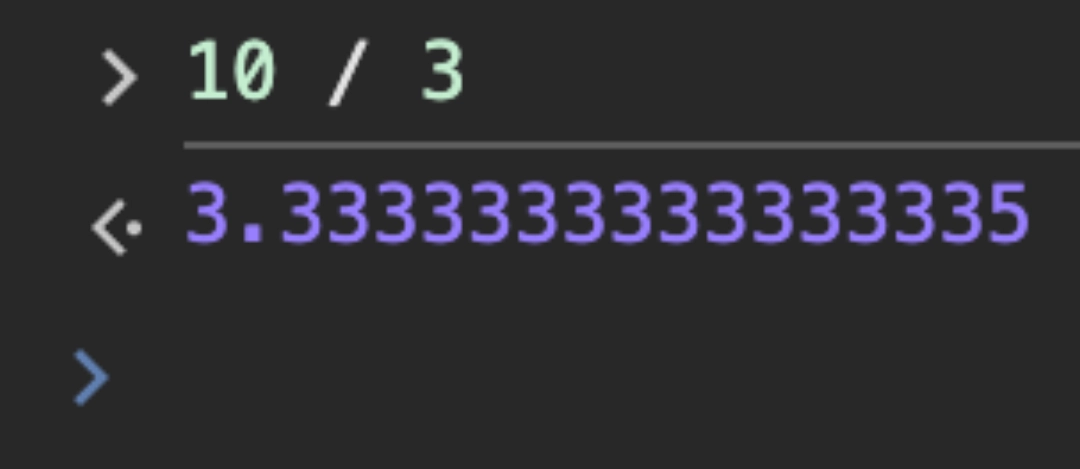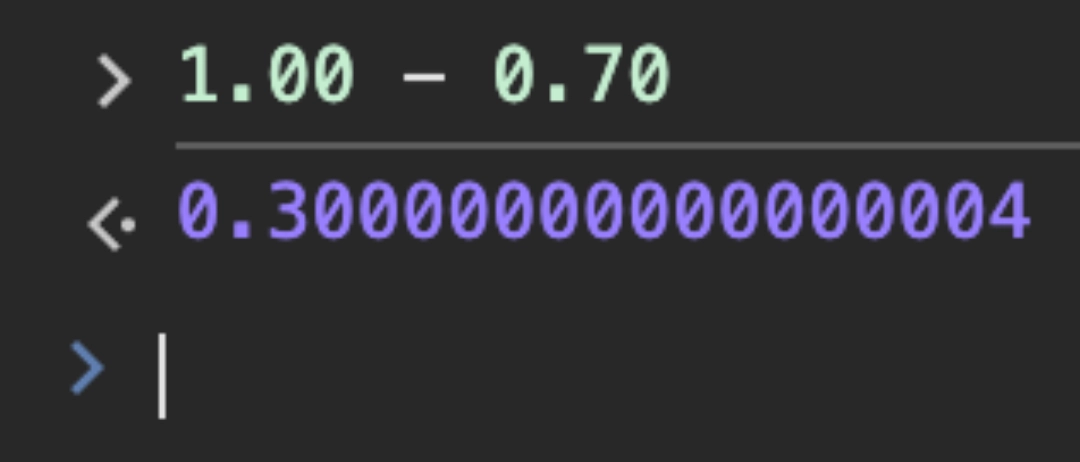It’s common knowledge that using Float (or Number in JavaScript, which is Float64 behind the scenes) to store monetary data is a bad idea. If you don’t know this yet, try doing 10 / 3 in your choice of programming language. I’ve seen a lot of LinkedIn posts ridiculing JavaScript for this.

When dealing with a user’s balance, let’s say in US Dollars, we sometimes need to deal with cent values. If a user has a balance of US$10.00 and we want to charge them 50 cents (US$0.50), they will have US$9.50 by the end of it. Doesn’t look wrong, right?
But what if the user only has US$1.00 and we charge them 70 cents (US$0.70)?

Mentally we already did the calculation and got US$0.30, but again when I tried the code in JavaScript, I got 0.30000000000000004. Now the customer has more money than they should have.
Huh, weird?
That couldn’t be right. Curse you JavaScript!
I mean, this problem can be found not only in JavaScript but also in all programming languages that use the IEEE 754 standard. So Golang has this problem too, run this piece of code if you don’t believe me.
Dealing with Decimal Places
So what should we use, then?
Worry not! We have other data types.
Throughout my career, I’ve seen there are two ways most developers handle this; either by using Integer or String.
When using Integer, we write US$1 as 100. Notice that there is no comma separator in the value. This way every calculation can be done in Integer, no more floating-point issues. This way, we will show 100 in API request/response and database to denote US$1.
When using String, we write US$1 as "1.00", then we parse it to Integer so we get a value like the previous example, do some calculation, and make it into String again to be stored in the database. This way we can show "1.00" in the API request/response while calculating them fully in Integer.
To be honest, I am a bit opinionated on this money-data-type approach.
I think the Integer approach is great since there is no extra step necessary for parsing value, but the downside is the API consumer has to be aware that 100 means US$1 and not US$100.
If you worked in backend, you know how silly it is to trust that the API consumer would have the same thought process as the API developer.
Personally, I liked the second approach where the API consumer can just pass String value of either "1" or "1.00" and we would still get the same Integer value of 100 to handle. But, I would store them as Integer not String so that parsing only happened when receiving request or before sending response.
Enter the JSON Interface
I would use JSON for most of my API, this is the format most consumers expect to get.
In Go, there are JSON interface methods that we can override to customize the behavior when receiving requests and sending responses. We will use this to eliminate the need to manually call the String to Integer parsing method every time.
Determining The Number of Decimal Places
Before we start, let’s talk a little bit about currency.
Most countries use 2 decimal places. There’s a country like Kuwait that uses 3 decimal places. And there are countries like Indonesia and Japan that use no decimal places at all. I haven’t found any country that uses more than 3 decimal places, yet.
Being ambitious, let’s say we want to support all currencies from every country in the world. Standardizing 3 decimal places on the backend would be great. On the frontend we don’t need to care; "1", "1.0", "1.00" or "1.000" will all be treated as "1.000". Less stress for the API consumers, less conflict we will have. LOL!
Overriding JSON Marshal/Unmarshal
Now that we have agreed to use 3 decimal places for all money data, let’s start by coding the implementation.
This is our starting point, just like all other Go Projects:
package main
import (
"fmt"
)
func main() {
fmt.Println("Hello, World!")
}
First, let’s create a custom data type:
type Money int64
Notice that we didn’t write it as type Money = int64, because this is Type Definition, not Type Alias.
The difference is when doing Aliasing, both data type are interchangeable, meaning we can pass int64 to functions that expect Money if it were alias of int64. But, in Type Definition, we need to explicitly cast int64 to Money before we can pass it to functions that expect Money.
Now that we have our custom data type, let’s add 2 methods to change the way we receive JSON request and send JSON response:
// UnmarshalJSON implements the json.Unmarshaler interface
func (m *Money) UnmarshalJSON(data []byte) error {
// remove quotes from string
s := strings.Trim(string(data), "\"")
// if negative, remove sign
isNegative := strings.HasPrefix(s, "-")
if isNegative {
s = s[1:]
}
// split by point
parts := strings.Split(s, ".")
if len(parts) > 2 {
return fmt.Errorf("invalid decimal format: %s", s)
}
// parse leading part
intPart, err := strconv.ParseInt(parts[0], 10, 64)
if err != nil {
return fmt.Errorf("invalid integer part: %v", err)
}
// multiply by 1000, later will add the trailing part
result := intPart * 1000
// parse trailing part, only if exist
if len(parts) == 2 {
// trim to at max 3 digits (additional decimal places will be ignored)
decimalPart := parts[1]
if len(decimalPart) > 3 {
decimalPart = decimalPart[:3]
}
// pad with additional zeros (if less than 3 decimal places)
for len(decimalPart) < 3 {
decimalPart += "0"
}
// parse
decimal, err := strconv.ParseInt(decimalPart, 10, 64)
if err != nil {
return fmt.Errorf("invalid decimal part: %v", err)
}
// combine leading and trailing part
result += decimal
}
// if negative, return back sign
if isNegative {
result = -result
}
*m = Money(result)
return nil
}
// MarshalJSON implements the json.Marshaler interface
func (m Money) MarshalJSON() ([]byte, error) {
// get non-negative value
value := int64(m)
sign := ""
if value < 0 {
sign = "-"
value = -value
}
// calculate leading and trailing digits
intPart := value / 1000
decPart := value % 1000
// always format to trailing 3 decimal
str := fmt.Sprintf("%s%d.%03d", sign, intPart, decPart)
return json.Marshal(str)
}
For request/response simulation, we will need a struct that has Money data type as the property:
type Data struct {
Value Money `json:"value"`
}
Now to simulate receiving request:
// receiving request
incoming := `{"value": "1"}`
var received Data
_ = json.Unmarshal([]byte(incoming), &received)
fmt.Println("incoming data parsed as int64:", received)
The result will look like this:
incoming data parsed as int64: {1000}
Whatever value being sent, be it "1", "1.0", "1.00" or "1.000", the backend will receive it as 1000. Neat, huh?
Now to simulate sending response:
// sending response
outgoing := Data{Value: 5000}
sent, _ := json.Marshal(outgoing)
fmt.Println("outgoing data converted to string:", string(sent))
The result will look like this:
outgoing data converted to string: {"value":"5.000"}
The Money data type will be automatically converted to string. Perfect!
Putting Them Up
The final result should looks like this:
package main
import (
"encoding/json"
"fmt"
"strconv"
"strings"
)
type Money int64
func (m *Money) UnmarshalJSON(data []byte) error {
// remove quotes from string
s := strings.Trim(string(data), "\"")
// if negative, remove sign
isNegative := strings.HasPrefix(s, "-")
if isNegative {
s = s[1:]
}
// split by point
parts := strings.Split(s, ".")
if len(parts) > 2 {
return fmt.Errorf("invalid decimal format: %s", s)
}
// parse leading part
intPart, err := strconv.ParseInt(parts[0], 10, 64)
if err != nil {
return fmt.Errorf("invalid integer part: %v", err)
}
// multiply by 1000, later will add the trailing part
result := intPart * 1000
// parse trailing part, only if exist
if len(parts) == 2 {
// trim to at max 3 digits (additional decimal places will be ignored)
decimalPart := parts[1]
if len(decimalPart) > 3 {
decimalPart = decimalPart[:3]
}
// pad with additional zeros (if less than 3 decimal places)
for len(decimalPart) < 3 {
decimalPart += "0"
}
// parse
decimal, err := strconv.ParseInt(decimalPart, 10, 64)
if err != nil {
return fmt.Errorf("invalid decimal part: %v", err)
}
// combine leading and trailing part
result += decimal
}
// if negative, return back sign
if isNegative {
result = -result
}
*m = Money(result)
return nil
}
// MarshalJSON implements the json.Marshaler interface
func (m Money) MarshalJSON() ([]byte, error) {
// get non-negative value
value := int64(m)
sign := ""
if value < 0 {
sign = "-"
value = -value
}
// calculate leading and trailing digits
intPart := value / 1000
decPart := value % 1000
// always format to trailing 3 decimal
str := fmt.Sprintf("%s%d.%03d", sign, intPart, decPart)
return json.Marshal(str)
}
type Data struct {
Value Money `json:"value"`
}
func main() {
// receiving request
incoming := `{"value": "1"}`
var received Data
_ = json.Unmarshal([]byte(incoming), &received)
fmt.Println("incoming data parsed as int64:", received)
// sending response
outgoing := Data{Value: 5000}
sent, _ := json.Marshal(outgoing)
fmt.Println("outgoing data converted to string:", string(sent))
}
Closing Up
Now you know (arguably) the best way to handle money data in Golang.
Joke aside, this approach is not the perfect (yet), for production you might want to add more handling such as arithmetic operations, validation rules, and formatting with currency.
But, so far, using this approach, you already get:
- Consistent decimal places handling
- Clean API request/response with string representation
- No floating-point arithmetic errors
I’d say that’s already enough for a starter (๑˃ᴗ˂)ﻭ
Photo by Mathieu Turle on Unsplash

